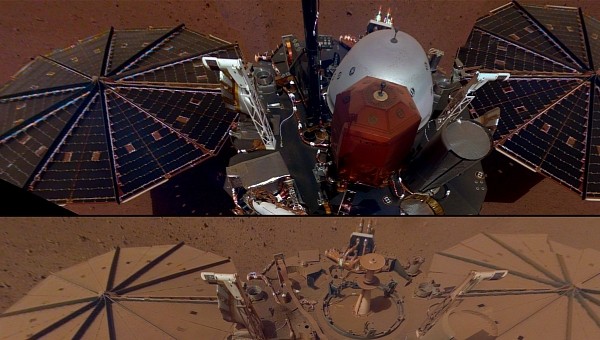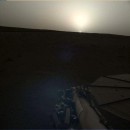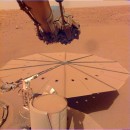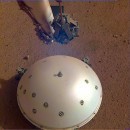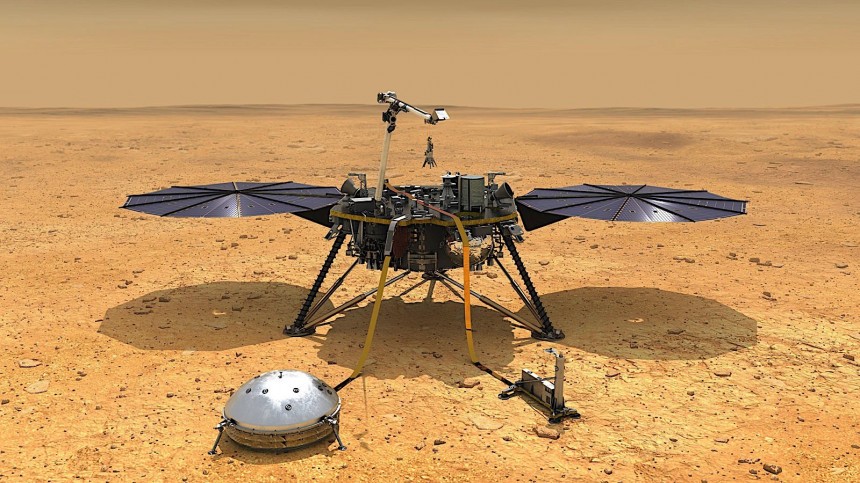Space probes without the benefit of being a rover tend to get lost in the news shuffle as more exciting mobile probes explore other heavenly bodies with a certain degree of autonomy. If you ask us, this shouldn't be the case. NASA's InSight Mars lander is a classic case in point.
NASA bade farewell to the prized Martian robotic lander this afternoon, just three days after the final efforts to communicate with the probe failed. It brings an end to a four-year-long saga that was largely overshadowed by the SUV-sized Curiosity and Perseverance rovers. But make no mistake, InSight's contributions to Martian exploration are more significant than you think.
In truth, the genesis of the InSight lander has its roots in NASA's previous Martian lander. This would, of course, be the Phoenix launched in 2008. This significant sharing of hardware between Phoenix and InSight was the main reason the program was one of three out of 28 proposals selected by NASA under the Discovery Program in May 2011. Production of the lander portion of InSight began at Lockheed Martin's Colorado production facility in May 2014.
From there, issues related to instrumentation and vacuum leaks in some of the lander's vital subsystems delayed the launch beyond the 2016 launch window. With all that sorted, InSight launched from Vandenberg Space Launch Complex 3 aboard an Atlas V medium-lift booster rocket on May 18th, 2018. Its destination was tens of millions of miles away, a region straddling the Martian equator called Elysium Planitia.
In a land full of subterranean volcanic activity that'd make Earth-bound geologists weak at the knees, novel scientific data was ripe for the picking for InSight. That is, assuming it could get there. Though dozens of probes have been sent to Mars over the last 60 years, close to half of them failed. But InSight did indeed brave the interplanetary cosmos and touched down on its new forever home on November 26th, 2018.
With a breadth of seismic, thermal, and barometric pressure reading instruments on board, InSight spent the next four years surveying around and beneath its surrounding environment. NASA's twin Viking probes also carried seismometer instruments. But neither could return much measurable data, at least on that particular front.
Some of the hardware present onboard InSight was borrowed from the defunct Phoenix probe, as was its iconic triple platter design. In this configuration, a central disk containing the probe's internals is flanked on either side by a circular photovoltaic panel.
This inner portion is referred to as the "science deck," which accounts for the majority of the lander's 358 kg (789 lb) curb weight. Around 50kg of which is dedicated to the scientific payload. Not bad for a space probe. That's in Earth-gravity weights, by the way.
Before the Perseverance Rover and its Ingenuity Mars Copter landed on mars in 2020, Phoenix's scientific instrument cluster was perhaps the most advanced on the Red Planet. With its Seismic Experiment for Interior Structure (SEIS) instrument, InSight could peer deep into the inner workings of Mars' subterranean environment.
A team of six international space agencies, universities, and technical institutes across the globe came together to build this one-of-a-kind martian seismometer. InSights' Heat Flow and Physical Properties Package (HP3) came courtesy of the German Aerospace Center based in Cologne.
Its job was to essentially work as a self-tapping screw. Boring its way as far as 16 feet (5 m) beneath the Martian regolith to achieve a greater understanding of how Martian seismic activity relates to subterranean thermal flow the same way the forces act on Earth.
With subsystems relating to Martian weather, geophysical experiments, and an Instrument Deployment Arm (IDA) that could manipulate Martian soil, there wasn't a base Insight that didn't cover that didn't involve flying. Though it's sadly bitten the dust both physically and literally, few interplanetary space probes accomplished so much in so little time, only to be overshadowed by flashier, more buzz-worthy space probes.
Thanks to InSight, scientists now know Mars undergoes tectonic-quake activity just like on Earth. On one occasion, InSight's seismometers detected a "marsquake" in its vicinity, which measured the equivalent of 5.0 on Earth's Richter Scale. Such insights will be nothing short of vital in helping future human explorers keep themselves safe when the Martian regolith decides to have a big boogaloo.
As we say goodnight and godspeed to InSight, it's important to remember so much of what's important to the advancement of spaceflight isn't flashy records that look good on social media. In those vital metrics, InSight was at the top of its class.
It's Celebration Month here on autoevolution, a whole month dedicated to showcasing the machines we love the most. With the timing lining up so wonderfully, we take this moment to thank InSight for its service to the advancement of humanity in space. Now, the only thing left to do is hand some humans nearby and put the probe in a museum back on Earth.
In truth, the genesis of the InSight lander has its roots in NASA's previous Martian lander. This would, of course, be the Phoenix launched in 2008. This significant sharing of hardware between Phoenix and InSight was the main reason the program was one of three out of 28 proposals selected by NASA under the Discovery Program in May 2011. Production of the lander portion of InSight began at Lockheed Martin's Colorado production facility in May 2014.
From there, issues related to instrumentation and vacuum leaks in some of the lander's vital subsystems delayed the launch beyond the 2016 launch window. With all that sorted, InSight launched from Vandenberg Space Launch Complex 3 aboard an Atlas V medium-lift booster rocket on May 18th, 2018. Its destination was tens of millions of miles away, a region straddling the Martian equator called Elysium Planitia.
In a land full of subterranean volcanic activity that'd make Earth-bound geologists weak at the knees, novel scientific data was ripe for the picking for InSight. That is, assuming it could get there. Though dozens of probes have been sent to Mars over the last 60 years, close to half of them failed. But InSight did indeed brave the interplanetary cosmos and touched down on its new forever home on November 26th, 2018.
With a breadth of seismic, thermal, and barometric pressure reading instruments on board, InSight spent the next four years surveying around and beneath its surrounding environment. NASA's twin Viking probes also carried seismometer instruments. But neither could return much measurable data, at least on that particular front.
This inner portion is referred to as the "science deck," which accounts for the majority of the lander's 358 kg (789 lb) curb weight. Around 50kg of which is dedicated to the scientific payload. Not bad for a space probe. That's in Earth-gravity weights, by the way.
Before the Perseverance Rover and its Ingenuity Mars Copter landed on mars in 2020, Phoenix's scientific instrument cluster was perhaps the most advanced on the Red Planet. With its Seismic Experiment for Interior Structure (SEIS) instrument, InSight could peer deep into the inner workings of Mars' subterranean environment.
A team of six international space agencies, universities, and technical institutes across the globe came together to build this one-of-a-kind martian seismometer. InSights' Heat Flow and Physical Properties Package (HP3) came courtesy of the German Aerospace Center based in Cologne.
With subsystems relating to Martian weather, geophysical experiments, and an Instrument Deployment Arm (IDA) that could manipulate Martian soil, there wasn't a base Insight that didn't cover that didn't involve flying. Though it's sadly bitten the dust both physically and literally, few interplanetary space probes accomplished so much in so little time, only to be overshadowed by flashier, more buzz-worthy space probes.
Thanks to InSight, scientists now know Mars undergoes tectonic-quake activity just like on Earth. On one occasion, InSight's seismometers detected a "marsquake" in its vicinity, which measured the equivalent of 5.0 on Earth's Richter Scale. Such insights will be nothing short of vital in helping future human explorers keep themselves safe when the Martian regolith decides to have a big boogaloo.
As we say goodnight and godspeed to InSight, it's important to remember so much of what's important to the advancement of spaceflight isn't flashy records that look good on social media. In those vital metrics, InSight was at the top of its class.
